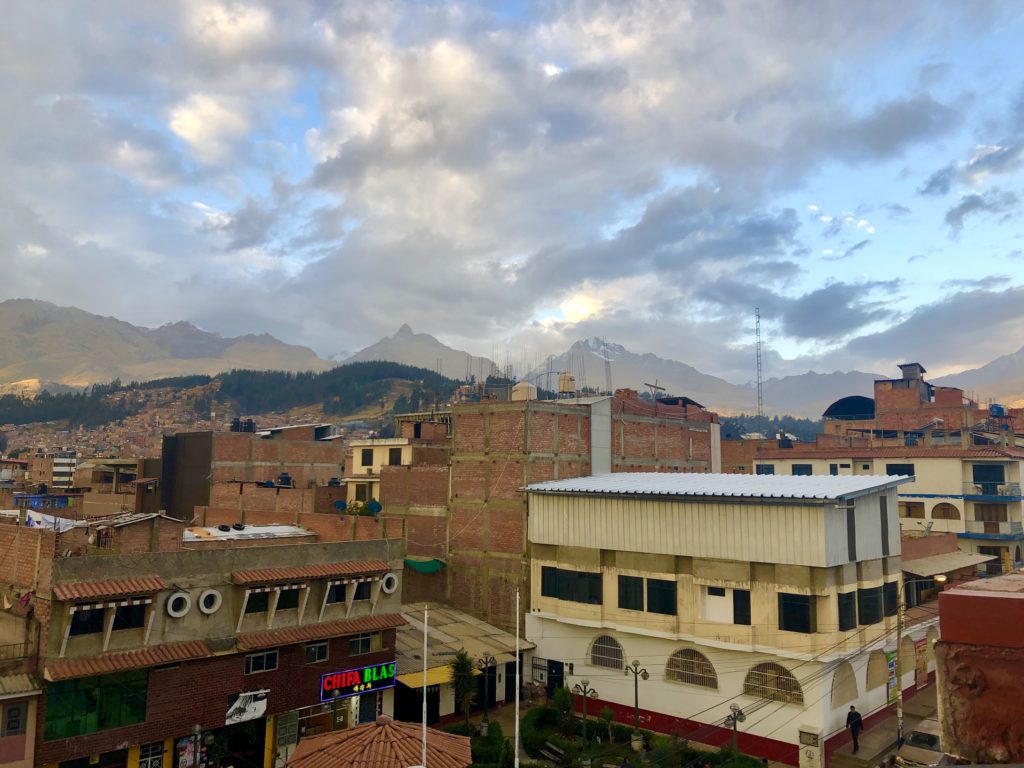- SHOPPING LIST
- TRANSPORTATION
- ACCOMMADATION
- PASTORURI GLACIER
- LAGUNA 69
- CHIFA
You aren’t necessarily going to Huaraz for the town itself, but all the outdoor activities around Huaraz. That’s not to say Huaraz doesn’t have any character, but it might be lacking in the charm department. However, if you’re smart enough to book an accommodation with a rooftop terrace, then you’ll get to enjoy the stunning views of the snow peaked mountains surrounding Huaraz.
Whether you are arriving from Ecuador to the north, or Lima from the south, you’re probably arriving from near sea level elevations, so you’re going to need some time to adjust to the altitude. That shortness of breath is normal, humans weren’t designed to function at these elevations, but the good news is that most people can adjust in a day or two.
There are so many activities to take part in around Huaraz, in Huascarán National Park, and you probably won’t see and do everything. Between skiing or snowboarding, multi-day treks, rock climbing, glaciers, and so much more, there’s pretty much something to explore for any outdoor enthusiast. We decided to stay in Huaraz for 2 days and 3 nights. The first day we challenged our bodies to a relatively short hike with moderate difficulty level to acclimate to the altitude and weather. The second day we went for a doozy and conquered a rigorous full day hike. Here’s a fair warning for you, if the locals tell you the hike is easy and anyone can do it, don’t believe them. Maybe most people can do them, but most people won’t do them easily.
Shopping List
To save you time on shopping and discomfort, come prepared for the cold. That means thick gloves, warm boots, wool socks, thermals and beanies. Because if you’re like us, and had never been to elevations of 15,000 feet above sea level with thin air and sub freezing temperatures, then it’s hard to imagine. We ended up purchasing double layer alpaca gloves and beanies on the streets in Huaraz, and ended up using those pretty much anytime we were in the Andes. We also learned the hard way that the thin, cold air is extremely dry. We were wondering why we were so itchy before coming to the conclusion that we needed to buy lotion for dry skin.
Transportation
To save you all the time we spent doing our own research, taking dirty buses, arriving at awkward hours, and sleeping on bus station benches in freezing weather, I recommend taking the Cruz Del Sur or Oltursa buses. The cost can be quite a bit more than the other companies but the quality and comfort is top notch and the scheduled departures and arrivals times are usually accurate.
It’s also a huge convenience to arrive at your destination at an hour with open cafes so that you have a place to hangout until your check-in time. For this stretch to Huaraz we actually took Movil tours, which wasn’t half bad for the price, and arrived later in the evening with time to check-in to our hostel and grab a quick bite to eat before retiring to bed.
Where We Stayed
We booked, through Hostelworld, a private room with a bathroom at Aldo’s Guesthouse for around 17 USD in central Huaraz and were happy with our choice. The host is Aldo himself and he was a big help with booking excursions. We never had any trouble, and the pickup locations were accurate and on time both days.
The positive aspects of the place were clean rooms, warm showers, rooftop terrace with views, and kitchen to store and prepare your food. The downsides were the lack of heat in the rooms, a bit of a sewage smell through the windows, and noise from late night activities if you have a street facing window.
The inclosed kitchen is located on the terrace roof and each night it seemed to be filled with people back from their excursions. The panoramic views of the mountains at sunset were spectacular, and in my opinion, the best part about Huaraz.
Pastoruri Glacier
We started our first full day with a trip to Pastoruri Glacier that sits at 16,400 ft (5,000 meters) above sea level. I know this sounds like an extremely high elevation, and it is, but it’s only a short hike from where the vans park. It’s also the highest point you’ll be reaching in the area, which gives you time to adapt to the altitude, and it’s good training for longer hikes at lesser elevation. That was the advice Aldo gave us and it really made a difference when we hiked Laguna 69 the following day.
The drive to and from the glacier was spectacular. It was difficult to really get a grasp on how enormous the landscape was around us. The peaks and valleys seemed to go on forever. Our tour guide was not particularly fluent in English, but he managed to teach me about the local people that live in the rock huts and the unique species of tree that only grows in the part of the world. I also had Rocio (from Spain) to translate, which obviously helped.
This hike, as for most hikes in Peru, definitely requires being in moderately good shape. I wouldn’t go as far to say that you need to be an athlete, but hiking up mountains in altitudes like these isn’t for everyone. It’s advisable to train a bit before arriving to Peru by practicing on difficult trails in your area, and then adjusting to the altitude in Huaraz for at least a day or two before attempting these treks. It’s also not a bad idea to bring a respiratory restriction mask in case you’re feeling any shortness of breath. The guides typically have them handy and we saw quite a few people need them. And don’t be that person that pushes him or herself too far. Humans aren’t built for these elevations, so there’s no shame in turning back, because there is going to be plenty else to see in Peru.
Laguna 69
Laguna 69, for us, was the highlight of our trip around Huaraz. It’s a full day hike that begins at 4:00 am when you get picked up in front of your accommodation. It’s a long, cold drive, so make sure you are plenty warm in order to get some extra sleep on the bus comfortably. It’s also important to pack a lunch the night before. We picked up bread, meat, cheese and avocado for sandwiches and fruit for snacks from the supermarket down the street from Aldo’s Guesthouse. This is important because you’ll need the energy to complete this hike. And make sure to bring enough water to last the entire day. We try to bring at least 2 liters each for a full day of hiking.
At sunrise the bus unloads everyone at an outdoor café for coffee and breakfast before continuing over dirt roads through rough landscape along cliff faces and turquoise blue lakes. You’ll have a chance to snap some photos at the large lake before arriving at the parking area. At the drop-off point you already have amazing landscape to observe and it only gets better as you ascend to the top. You’ll follow a stream all the way to the top, where it turns into a waterfall at one point, and is sourced from the snowmelt lakes at the summit. Your guide will be keeping a headcount and stick with the slowest hikers of the group. He or she will give you a timetable to be at the farthest point, the final lake, and also a recommended time to start your descent back down to the bus.
To handle the altitude and finish this hike, while also making it to that Kodak moment, its advised to stop frequently to catch your breath, nibble on some snacks and drink some water, in order to adjust to the altitude. The first part of the hike is somewhat easy, compared to the second half, and meanders through a marshy valley full of healthy looking cows. After that you’ll hit some switchbacks and pass a waterfall with a view of the valley you just hiked. Once the terrible switchbacks end you will reach a small lake and another valley at the foot of the glacier to give you a bit of breather before heading up some more switchbacks. It was at this moment that we really started feeling the altitude and were forced to take a couple breaks. In the end it is so worth it. It’s difficult to explain the beauty of the lake, surrounding glacier, and mountain peaks.
The way down wasn’t necessarily a walk in the park, but certainly less taxing than the ascent. Just make sure to watch your step and avoid rolling an ankle, an easy thing to do when you’re fatigued. If you are not too exhausted on the drive back it’s worth it to see the drive you missed in the dark earlier that day. The vastness of the Andes Mountains is on full display as you make your way down to Huaraz through dramatic landscapes and farming villages during sunset.
Chifa
We arrived in Huaraz famished, dropped off our stuff, took long hot showers, and looked for some grub. One of the big surprises to us was the amount of Asian themed restaurants in Peru. And as it turns out there is a big Chinese population that immigrated to Peru in the 1960s and 1970s, and for this reason you can find Chifa, a type of Chinese-Peruvian cuisine containing many types and rice and noodle stir fries and soups mixed with potatoes and other local ingredients. We got our first taste of this Chifa after the Laguna 69 outing and it was perfectly delicious and hearty, the perfect cap to a tiring and worthwhile day.
Synopsis
The Pastoruri Glacier and Laguna 69 were the only excursions we had time for in Huaraz because we had so many more places to visit within our three week window in Peru. It was a great place to kick off our outdoor exploring and an amazing introduction to the Andes Mountains. We didn’t expect to be challenged as much as we were by the altitude and Laguna 69 hike, but it was a great way to prepare for our final destination, Machu Picchu.




